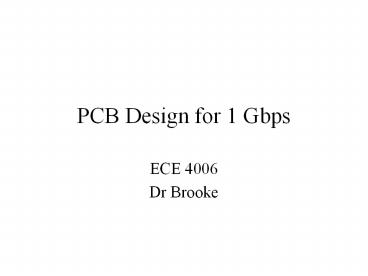PCB Design for 1 Gbps PowerPoint PPT Presentation
Title: PCB Design for 1 Gbps
1
PCB Design for 1 Gbps
- ECE 4006
- Dr Brooke
2
Overview
- What signals are being routed?
- How can you route those signals?
- How to apply routing to PCB?
- PCB design techniques
3
Signals being routed
- High Frequency Sensitive Analog (e.g., IN from
PD) - High Frequency Data, and Noisy Analog (e.g.,
OUT from Limiting Amp, OUT from VCSEL driver) - Low Frequency sensitive Bias, Analog (e.g., DC
Power on input side of most chips esp. TIA) - Low Frequency insensitive Bias, Analog (e.g., DC
Power on output side of most chips, low frequency
data)
4
Signal Type Matrix
Sensitivity Frequency high low
high high/high, e.g., TIA input high/low, e.g., VCSEL driver outputs
Low low/high, e.g., input side power low/low, e.g., output side power
- Red Challenging, Yellow Care needed, Green
Easy
5
Different Types NeedDifferent Treatment
- High Frequency/High Sensitivity
- Transmission lines, return path (decoupling),
Shielding from high frequency - High Frequency/Low Sensitivity
- Transmission lines, prevent coupling to sensitive
- Low Frequency/High Sensitivity
- Shielding from high frequency, return path
(ground loops), - Low Frequency/Low Sensitivity
- Low Frequency decoupling, Resistive Loss
6
High Frequency/High Sensitivity
- Transmission line issues
- Signal return path issues (decoupling)
- Shielding from larger high Frequency signals
7
Transmission line issues
- What is a Transmission line? What is not?
- How to avoid (short lines)
- How to use (50 ohms)
- Non traditional transmission lines (turns,
tapers)
8
What is a Transmission line
1 wavelength
20 cm _at_ 500 MHz,
EM wave
¼ wavelength or greater transmission line 5 cm
1/10 wavelength or less wire 2 cm
- Less that 1/10 of a wavelength use arbitrary
geometry connections - More that ¼ wave length use wideband RF design
techniques for geometry (stripline, coplanar) - In between use special angles, tapers, curves
9
What is a Transmission line
- What frequency to use?
- Gbps data 500 MHz sq wave (10101010)
Square Wave 1st 3rd 5th Harmonics
Using up to 5th harmonic has eye closure 15
Using up to 3rd harmonic has eye closure 30
Using only 1st harmonic has eye closure 50
10
How to avoid Transmission lines?
- Depending on eye you want chose appropriate
harmonic length to be less than a 1/10th of a
wavelength
First Harmonic 1/10 20 cm 2 cm
Second harmonic (present in real data) 2 cm / 2
1 cm
Fifth Harmonic 4 mm
Third Harmonic 6.7 mm
Fourth Harmonic 5 mm
11
How to avoid Transmission lines?
- For Gigabit Ethernet
- Nice eye for lines less than 4 mm not a
transmission line - OK eye for lines less than 7 mm not a
transmission line - Poor eye for lines less than 2 cm not a
transmission line
12
How to use Transmission Lines
- Terminate them in design impedance
- Ensure high frequency return path
- Signal returns along the shield of Coax
50 ohms
Signal arrives after transmission delay.
sees 50 ohms immediately between core and
shield - nothing else if terminated
properly - echo after 2 x transmission
delay otherwise
13
How to use Transmission Lines
- Special Case for Balanced Differential Signals
- Connect shields together
sees 50 ohms immediately between core and
shield
Balanced equal and opposite That is for AC
components (OUT) -(-OUT)
14
How to use Transmission Lines
- Eliminate reflective features larger than 1/10th
of a wavelength - Avoid impendence changes
OK
BAD
45 deg
45 deg
1/10th wavelength
1/10th wavelength
15
Non traditional transmission lines (curves,
tapers)
- If you want to use these features either
- Do it in the transition region between 1/10th and
¼ wavelength - Or use an RF design tool (e.g., ADS) to verify
operation with finite element analysis
16
Signal return path issues (decoupling)
- Every High Frequency input and output
- All AC current out/in must return to both
nearby supplies
VCC
OUT
Load
VEE
Decoupling Capacitor Must be a short at
signal frequency
ground path minimum length!
17
Decoupling Capacitors
- www.murata.com/cap/lineup
- We are using 1.6 mm x 0.8 mm (0603) caps
18
Decoupling caps
- 10000 pF 0.01 uF
- S11 reflected/incident power ratio when
grounded - S21 ratio of power passed to 50 ohm load
19
Shielding from high Frequency
20
High Frequency/Low Sensitivity
- Transmission line issues
- prevent coupling to sensitive
21
Low Frequency/High Sensitivity
- Shielding from high frequency
- Return path (ground loops)
22
Low Frequency/Low Sensitivity
- Low Frequency decoupling
- Resistive Loss
23
How to apply routing to PCB
- fff
24
PCB design techniques
- fff

